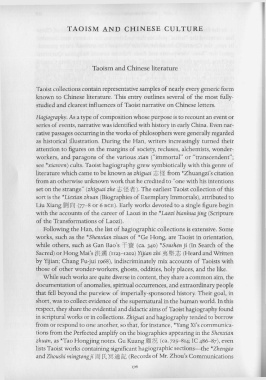Page 216 - The Encyclopedia of Taoism v1_A-L
P. 216
TAOISM AND CHINESE CULTURE
Taoism and Chinese literature
Taoist collections contain representative samples of nearly every generic form
known to Chinese literature. This entry outlines several of the most fully-
studied and clearest influences of Taoist narrative on Chinese letters.
Hagiography. As a type of composition whose purpose is to recount an event or
series of events, narrative was identified with history in early China. Even nar-
rative passages occurring in the works of philosophers were generally regarded
as historical illustration. During the Han, writers increasingly turned their
attention to figures on the margins of society, recluses, alchemists, wonder-
workers, and paragons of the various xian ("immortal" or "transcendent";
see *xianren) cults. Taoist hagiography grew symbiotically with this genre of
literature which came to be known as zhiguai itH~ from *Zhuangzi's citation
from an otherwise unknown work that he credited to "one with his intentions
set on the strange" (zhiguai zhe it ,t?t 1!f). The earliest Taoist collection of this
sort is the *Liexian zhuan (Biographies of Exemplary Immortals), attributed to
Liu Xiang ~~ rPJ (77-8 or 6 BCE). Early works devoted to a single figure begin
with the accounts of the career of Laozi in the *Laozi bianhua jing (Scripture
of the Transformations of Laozi).
Following the Han, the list of hagiographic collections is extensive. Some
works, such as the *Shenxian zhuan of *Ge Hong, are Taoist in orientation,
while others, such as Gan Bao's -=fI!f (ca. 340) *Soushenji (In Search of the
Sacred) or Hong Mai's #{J!I (I123-1202) Yijian zhi ~~ it (Heard and Written
by Yijian; Chang Fu-jui 1968), indiscriminately mix accounts of Taoists with
those of other wonder-workers, ghosts, oddities, holy places, and the like.
While such works are quite diverse in content, they share a common aim, the
documentation of anomalies, spiritual occurrences, and extraordinary people
that fell beyond the purview of imperially-sponsored history. Their goal, in
short, was to collect evidence of the supernatural in the human world. In this
respect, they share the evidential and didactic aims of Taoist hagiography found
in scriptural works or in collections. Zhiguai and hagiography tended to borrow
from or respond to one another, so that, for instance, *Yang Xi's communica-
tions from the Perfected amplify on the biographies appearing in the Shenxian
zhuan, as *Tao Hongjing notes. Gu Kuang RfJ[r.£ (ca. 725-814; rc 486-87), even
lists Taoist works containing Significant hagiographic sections-the *Zhengao
and Zhoushi mingtongji JtD IX; ~:® 13c (Records of Mr. Zhou's Communications

